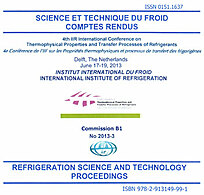
Document IIF
Utilisation de nouvelles données sur les propriétés pour le calcul d'enthalpie et d'entropie de solutions d'ammoniac/sel.
Using new property data for enthalpy and entropy calculation of ammonia/salt solutions.
Numéro : pap. n. TP-022
Auteurs : GAROUSI FARSHI L., INFANTE FERREIRA C. A., SEYED MAHMOUDI S. M., et al.
Résumé
Absorption refrigeration systems using ammonia/LiNO3 and ammonia/NaSCN as working fluids can be alternatives to ammonia/water systems, since they have higher coefficients of performance and no need to purify the vapor. Many analyses of these cycles reported in the literature use thermophysical properties correlations based on old data, which recently have been shown not to be sufficiently reliable and sometimes not to have adequate working ranges for absorption refrigeration applications. Properties of the working fluids used in absorption refrigeration cycles are important and need to be accurate. Also, it is increasingly accepted that exergy analysis provides more meaningful information when assessing the performance of energy conversion systems. In order to perform exergy analysis of absorption refrigeration cycles the entropy of solutions are needed as well. In this study, enthalpy and entropy data for these solutions are calculated using the most recently published property data. The procedures for these calculations are described in detail and the results are compared with data from the literature.
Documents disponibles
Format PDF
Pages : 8 p.
Disponible
Prix public
20 €
Prix membre*
Gratuit
* meilleur tarif applicable selon le type d'adhésion (voir le détail des avantages des adhésions individuelles et collectives)
Détails
- Titre original : Using new property data for enthalpy and entropy calculation of ammonia/salt solutions.
- Identifiant de la fiche : 30008101
- Langues : Anglais
- Source : 4th IIR Conference on Thermophysical Properties and Transfer Processes of Refrigerants
- Date d'édition : 17/06/2013
Liens
Voir d'autres communications du même compte rendu (69)
Voir le compte rendu de la conférence
Indexation
-
Thèmes :
Ammoniac;
Systèmes à absorption et adsorption - Mots-clés : Fluide actif; Calcul; Ammoniac; Absorption; Entropie; Enthalpie
-
First and second law analysis of ammonia/salt a...
- Auteurs : GAROUSI FARSHI L., INFANTE FERREIRA C. A., MAHMOUDI S. M. S., et al.
- Date : 04/2014
- Langues : Anglais
- Source : International Journal of Refrigeration - Revue Internationale du Froid - vol. 40
- Formats : PDF
Voir la fiche
-
Comment on ``first and second law analysis of a...
- Auteurs : SINGH D. V., VERMA T. N.
- Date : 01/2020
- Langues : Anglais
- Source : International Journal of Refrigeration - Revue Internationale du Froid - vol. 109
- Formats : PDF
Voir la fiche
-
Corrigendum to “First and second law analysis o...
- Auteurs : GAROUSI FARSHI L., INFANTE FERREIRA C. A., MAHMOUDI S. M. S., et al.
- Date : 01/2020
- Langues : Anglais
- Source : International Journal of Refrigeration - Revue Internationale du Froid - vol. 109
- Formats : PDF
Voir la fiche
-
EVALUATION OF THERMODYNAMIC PROPERTIES OF BINAR...
- Auteurs : BORDE I., JELINEK M.
- Date : 1987
- Langues : Anglais
Voir la fiche
-
THE EXCESS ENTHALPY AND VOLUME OF THE AMMONIA-W...
- Auteurs : KOUREMENOS D. A., STEGOUSAGIA A., ROGDAKIS E.
- Date : 24/08/1987
- Langues : Anglais
- Source : Development in refrigeration, refrigeration for development. Proceedings of the XVIIth international Congress of Refrigeration.
- Formats : PDF
Voir la fiche
